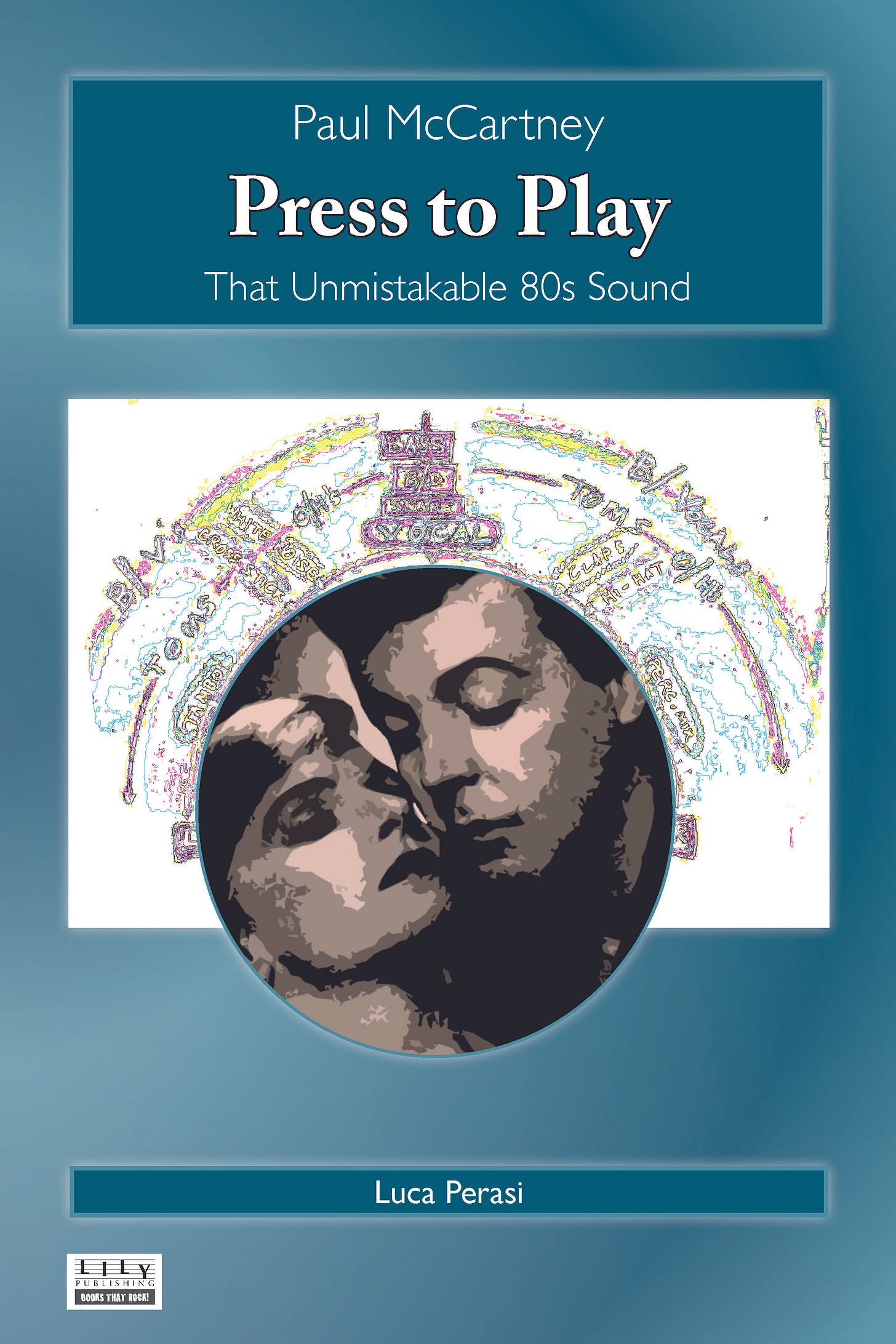Book Review – Paul McCartney 'Press To Play:' That Unmistakable 80s Sound
A re-evaluation of McCartney's 1986 album with a view from the 21st century
Paul McCartney didn’t intentionally go out to make an album that you’d hate in 1986. He didn’t decide to have a go at the latest ‘thing’ just to make it look like he was the cool, hip artist who was desperately trying to bounce back from a critical failure (Give My Regards To Broad Street). No, what really happened was the Eighties.
While we’re still trying to figure out if that’s the case, author Luca Perasi has gone deep with Paul McCartney Press To Play: That Unmistakable 80s Sound. Peppered with previously published anecdotes from those at the sessions, personal interviews, and photos, he nails it within the first couple of pages. This wasn’t about what McCartney wanted or what the ‘80s deemed necessary. This was about how two people on opposite sides of the musical spectrum — Eric Stewart and Hugh Padgham — ultimately failed in their efforts to satisfy how Press To Play was delivered.
Perasi begins the untangling right from the start, as to whether the invitation extended to produce a new project with Stewart, already a collaborator on Tug of War and Pipes of Peace, was then co-opted or hijacked by McCartney by bringing in another set of ears. Padgham arrived in April 1985 at the newly built home studio that McCartney christened Hog Hill Mill in Sussex, England, and had some minor non-disagreeable requests from a recording standpoint. But for the location, its newness in discovering the wonders of digital recording and leisurely pace, everyone was eagerly looking forward to what was essentially uncharted territory.

However, the demos immediately presented a problem to Padgham: he thought they sounded like McCartney and Stewart were huddled around a campfire with their acoustics. And the discomfort emanating from Stewart once Padgham was fully on board would prove to be the most challenging recording sessions of McCartney’s career.
One observation that has spanned McCartney’s career is irrefutable: he is the boss, and while he appreciates feedback, more than likely, he will get people to come over to his line of thinking. Perasi gives over some observational insight from drummer Jerry Marotta, which shows that, however one might think you need to be a ‘yes’ man to Macca, he wouldn’t be one of them. Yet he remained enthusiastic in his contributions… even if McCartney would grab the drummer’s seat quite a few times during the studio sessions.
The real underlying rift was squarely between Stewart and Padgham. While the former 10cc guitarist had been closely aligned musically with McCartney and preferred an organic and loose approach, it was Padgham who ultimately played his hand to get the album under control in a passive-aggressive manner that saw Stewart’s role greatly diminished. This has led to some (or possibly, a lot) of bitterness from Stewart that has reflected poorly from a personal standpoint in the intervening years (just as the late Denny Laine learned post-McCartney II), which has not helped Press To Play’s reputation.
However, during a break in recording, an event occurred in the summer of 1985 that altered the entire course of pop music, including McCartney’s.
Paul McCartney – Backstage Interview (Live Aid 1985)/© Band Aid Trust/YouTube
One of the more fruitful experiences Perasi mentions is the session one week after Live Aid for “Angry,” a McCartney/Stewart track that had been previously recorded and set aside. With the inclusion of Phil Collins and Pete Townshend, the RPMs were dialed up past 11 for one of the most blistering rock tracks McCartney had recorded in quite some time.
Angry (1993 Digital Remaster)/℗© 1993 MPL Communications Inc/Ltd, under exclusive license to Universal Music Enterprises, a Division of UMG Recordings, Inc./YouTube
One interesting (and surprising) aspect was the arc of impostor syndrome that permeated throughout the process. If one thing comes through loud and clear, it’s McCartney’s insecurity during this time. While not fully explainable, despite access to unquestionable talent from around the music community, the overall tone Perasi leans toward is a lack of direction with the best of intentions. Everyone involved, including musicians such as Carlos Alomar and Nick Glennie-Smith, wanted to give it their best, but couldn’t understand the palpable rudderless vibe that the project gave off.
Much to his credit, Padgham continued working with the bassist in September and October of 1985 on the title song for the Dan Aykroyd/Chevy Chase hijinks comedy Spys Like Us. McCartney and Padgham included producer Phil Ramone, who helped pull off a quirky, beat-heavy production that, at least for the former Beatle, looked like a win-win partnership and gave him a Number 7 hit in the U.S. But notwithstanding the support of Padgham, it was a one-off project specific to the movie and, with hindsight, feels like another science project for McCartney that, in truth, required more follow-through than he was willing to give.
Paul McCartney – Spies Like Us/℗© MPL Communications Ltd./Warner Bros.Records Inc./You Tube
Padgham had to break to begin production with Genesis for what ended up becoming Invisible Touch, with an eventual return to Hog Hill Mill to finish in early 1986. Finally, at the conclusion of recording the 15 tracks with the producer (who also served as an engineer and mixer), an admittedly bored McCartney took up doodling with crayons that ended up as illustrations for the mixing sequence across the stereo spectrum.
Perasi then details the album’s songs in structure, contribution, instrumentation, inspiration and large portions dedicated to released and unreleased songs recorded during the period, the album cover photography (done by legendary Hollywood icon George Hurrell, decorated by an amusing ancedote from McCartney) and of course, the music video shot for “Press.” For that, McCartney and a small crew went commando and filmed in blasts on London’s Underground on June 16, 1986.
Paul McCartney: “Press” Music Video (1986)/℗© MPL Communications Ltd./YouTube
Perasi concludes with a lengthy analysis from a legacy and contemporary perspective, giving over many quotes from McCartney at the album’s release that pushed neither negatively nor positively about Press To Play. As noted, perhaps it suffered from trying too hard to be hip, or that the material wasn’t strong enough to begin with, both points taken up by the critics. Standing back at a 40-year staredown, what emerges is one of the world’s most successful artists caught in the middle of a career crisis.
Only six years removed from the death of John Lennon, McCartney had not yet fully embraced his ‘Beatleness,’ despite the Live Aid appearance. He was not touring, except for the occasional appearance, including the 1986 Prince’s Trust with a galaxy of admirers and peers, and that pointedly reflected in his aimless directions and choices.
However, with a change in personal management and an appointment with a fellow Liverpudlian named Elvis Costello in late 1986, McCartney started to reclaim some of what was lost. Perasi makes for a balanced ending that includes many sources – including its creator – that may not completely satisfy Macca fans, but should certainly give a deeper and better understanding of where McCartney was and how he got there in giving us Press To Play.
Paul McCartney Press To Play: That Unmistakable 80s Sound is available to purchase at worldwide Amazon portals from Perasi’s website. You’ll gain greater insight into Perasi’s work in this interview from last November on The Paul McCartney Project.







Brilliant Amy, finding gems like this. ❤️🎵
I was a huge fan of both "Tug of War" and "Pipes of Peace." I also loved "No More Lonely Nights" from "Give My Regards to Broad Street" but I have only a vague memory of "Press to Play." I think "Press" was a single that didn't make much of a dent on the charts. I had never thought about when McCartney faded for me but I guess this was that album. When I look at what he did afterwards only "Egypt Station" crossed my wires. Makes me want to explore this later stuff more to find some gems I know must be there!